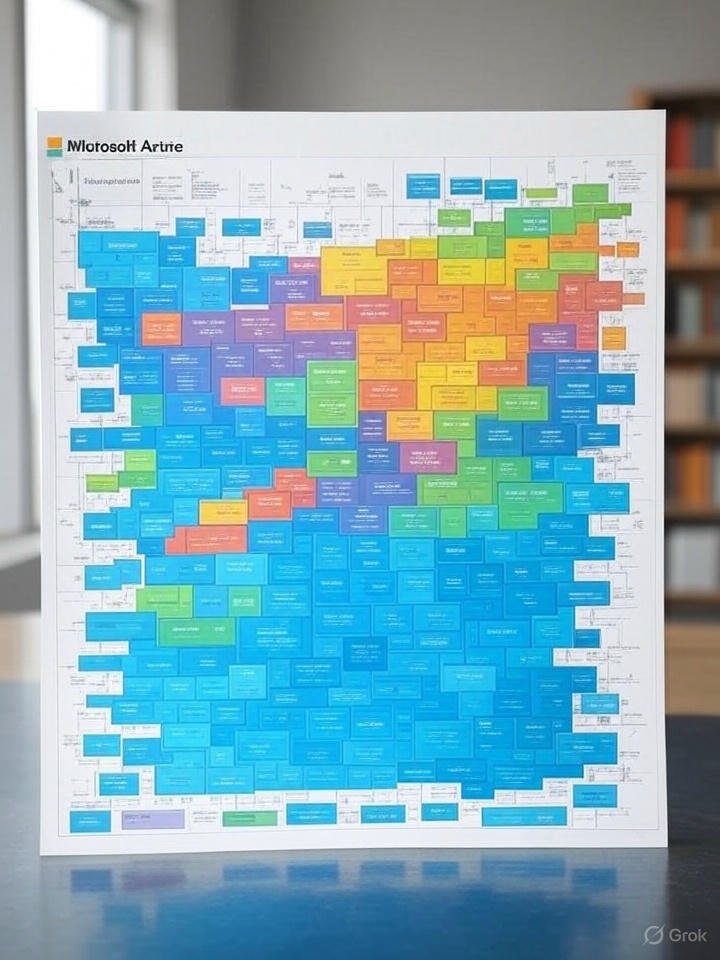The future of cloud computing is being shaped by innovation, and Microsoft is leading the charge. As businesses around the world increasingly depend on scalable, AI-powered cloud platforms, understanding the Microsoft Azure roadmap 2025-2030 becomes crucial. In this article, we’ll break down Microsoft’s cloud vision, examine the evolution of Azure, and explore how Azure Copilot and other advanced tools are shaping the decade ahead.
Whether you’re a tech leader, developer, or enterprise decision-maker, knowing what’s in Microsoft’s cloud plan will help you make smarter choices for your digital infrastructure.
Microsoft Azure Roadmap 2025-2030: The Big Picture
Microsoft’s cloud strategy is centered around four pillars: scalability, AI integration, sustainability, and global reach. According to the Azure roadmap page, the next five years will see Microsoft expand its infrastructure, enhance AI features like Copilot, and tighten security layers across the board.

Key Focus Areas:
- AI-First Infrastructure: Microsoft plans to embed AI into the core of Azure services, especially with tools like Copilot powering real-time insights and automation.
- Sustainability: The roadmap outlines a path toward carbon-negative cloud infrastructure by 2030.
- Global Accessibility: Microsoft is investing in more regional data centers to ensure faster speeds and compliance with local regulations worldwide.
- Hybrid Cloud: Azure Arc and related services will continue to bridge on-premise and multi-cloud environments.
How Azure Copilot Is Changing the Game
Among the most talked-about innovations in Microsoft’s roadmap is Azure Copilot — an AI assistant integrated into various Microsoft services, helping developers write code, manage data, and optimize performance in real-time.
Benefits of Copilot in Azure:
- Speeds up deployment and debugging
- Provides intelligent suggestions for cloud architecture
- Helps teams automate routine cloud tasks
- Integrates deeply with Visual Studio and GitHub Copilot
By 2030, Copilot will likely become a default part of Azure workflows, driving efficiency across industries.
Why This Roadmap Matters to Global Enterprises
The Microsoft Azure roadmap 2025-2030 isn’t just about new features — it's about reshaping how enterprises operate globally. Microsoft’s strategy focuses on making the cloud more:
- Secure with zero-trust architecture
- Intelligent with machine learning capabilities
- Compliant with regional data laws
- Scalable to meet both SMB and enterprise needs
For global businesses, this means more control, better compliance, and faster innovation cycles — no matter where you are.
What’s in Microsoft’s Cloud Plan?
Let’s break it down by year and theme based on available details from the Azure roadmap page and recent announcements.
📆 2025-2026: AI Everywhere
- Full-scale rollout of Azure Copilot across services
- Enhanced integration with Power Platform and Microsoft 365
- Azure Stack improvements for hybrid edge computing
📆 2027–2028: Sustainable Infrastructure
- Expansion of renewable-powered data centers
- Smart grid integration and AI-based energy optimization
- Greener Azure SDKs and tools for developers
📆 2029-2030: Intelligent, Autonomous Cloud
- Real-time AI orchestration across global workloads
- Predictive cloud cost optimization
- Automated compliance management and zero-downtime SLAs
This roadmap signals a move toward an autonomous, intelligent cloud system that learns and evolves with business needs.
Subscribe to Azure: The Functional Step Toward Innovation
If your business hasn’t yet adopted Azure, now is the time. Microsoft offers easy ways to subscribe to Azure, with scalable pricing models, free trial tiers, and dedicated support.
By subscribing early, companies can:
- Access early versions of Copilot and next-gen tools
- Gain migration support and architecture consulting
- Join the Azure partner network for added benefits
Microsoft encourages users to explore the Azure roadmap page regularly to stay ahead.
Microsoft’s Competitors: Still Catching Up?
While AWS and Google Cloud remain significant players, Microsoft’s focus on AI integration and enterprise needs gives it an edge in the coming decade. The Microsoft Azure roadmap 2025-2030 reflects a proactive approach that focuses not just on raw performance but also usability, intelligence, and sustainability.
By targeting developer productivity, end-user empowerment, and environmental responsibility, Microsoft aims to make Azure more than just a cloud — it’s an ecosystem.
Navigating the Azure Roadmap Page
For updates, tools, and detailed schedules, Microsoft provides an official Azure roadmap page. This resource includes:
- Upcoming feature releases
- Previews and beta test links
- Region-specific updates
- Feedback loops for community involvement
Bookmarking this page is essential if you want to stay aligned with what Microsoft is rolling out.
For a broader look at how Apple is approaching AI in the coming years, check out our breakdown of the Apple AI Roadmap 2030.
Why the Microsoft Azure Roadmap 2025-2030 Matters for Global Enterprises
Understanding the Microsoft Azure roadmap 2025-2030 is essential for businesses aiming to stay ahead in a rapidly evolving digital landscape. As cloud computing becomes the backbone of global operations, Microsoft’s vision includes deeper AI integration, Copilot enhancements, and a more scalable, secure infrastructure. This roadmap serves not just as a tech forecast but as a guide for strategic planning across industries.
Conclusion: Prepare for the Microsoft Cloud Evolution
The Microsoft Azure roadmap 2025-2030 is more than a set of tech updates — it’s a comprehensive vision of a smarter, cleaner, and more integrated future. From the rollout of Azure Copilot to investments in global infrastructure, Microsoft is preparing to redefine how we think about cloud services.
If you’re a business operating on the global stage, understanding what’s in Microsoft’s cloud plan is crucial. Whether you're considering when to subscribe to Azure or exploring how to adopt AI into your workflows, Microsoft’s roadmap provides the guidance and tools to do it right.
Ready to future-proof your cloud strategy?
Visit the Azure roadmap page and start exploring today.






